Baroque sculpture
Baroque sculpture is the sculpture associated with the Baroque style of the period between the early 17th and mid 18th centuries. In Baroque sculpture, groups of figures assumed new importance, and there was a dynamic movement and energy of human forms—they spiralled around an empty central vortex, or reached outwards into the surrounding space. Baroque sculpture often had multiple ideal viewing angles, and reflected a general continuation of the Renaissance move away from the relief to sculpture created in the round, and designed to be placed in the middle of a large space—elaborate fountains such as Bernini's Fontana dei Quattro Fiumi (Rome, 1651), or those in the Gardens of Versailles were a Baroque speciality. The Baroque style was perfectly suited to sculpture, with Gian Lorenzo Bernini the dominating figure of the age in works such as The Ecstasy of St Theresa (1647–1652).[1] Much Baroque sculpture added extra-sculptural elements, for example, concealed lighting, or water fountains, or fused sculpture and architecture to create a transformative experience for the viewer. Artists saw themselves as in the classical tradition, but admired Hellenistic and later Roman sculpture, rather than that of the more "Classical" periods as they are seen today.[2]
.jpg)
Baroque sculpture followed Renaissance and Mannerist sculpture and was succeeded by Rococo and Neoclassical Sculpture. Rome was the earliest centre where the style was formed. The style spread to the rest of Europe, and especially France gave a new direction in the late 17th century. Eventually it spread beyond Europe to the colonial possessions of the European powers, especially in Latin America and the Philippines.
The Protestant Reformation had brought an almost total stop to religious sculpture in much of Northern Europe, and though secular sculpture, especially for portrait busts and tomb monuments, continued, the Dutch Golden Age has no significant sculptural component outside goldsmithing.[3] Partly in direct reaction, sculpture was as prominent in Catholicism as in the late Middle Ages. Statues of rulers and the nobility became increasingly popular. In the 18th century much sculpture continued on Baroque lines—the Trevi Fountain was only completed in 1762. The Rococo style was better suited to smaller works.[4]
Origins and Characteristics

The Baroque style emerged from Renaissance sculpture, which, drawing upon classical Greek and Roman sculpture, had idealized the human form. This was modified by Mannerism, when the artist and scholar Giorgio Vasari (1511–1574) urged artists to give their works a unique and personal style. Mannerism introduced the idea of sculptures featuring strong contrasts; youth and age, beauty and ugliness, men and women. Mannerism also introduced the figura serpentina, which became a major characteristic of Baroque sculpture. This was the arrangement of figures or groups of figures in an ascending spiral, which gave lightness and movement to the work. [5]
Michelangelo had introduced figure serpentine in The Dying Slave (1513–1516) and Genius Victorious (1520–1525), but these works were meant to be seen from a single point of view. In the late 16th century work of the Italian sculptor Giambologna, The Rape of the Sabine Women (1581–1583). introduced a new element; this work was meant to be seen not from one, but from several points of view, and changed depending upon the viewpoint, This became a very common feature in Baroque sculpture. The work of Giambologna had a strong influence on the masters of the Baroque era, particularly Bernini. [5]
Another important influence leading to the Baroque style was the Catholic Church, which was seeking artistic weapons in the battle against the rise of Protestantism. The Council of Trent (1545–1563) gave the Pope greater powers to guide artistic creation, and expressed a strong disapproval of the doctrines of humanism, which had been central to the arts during the Renaissance.[6] During the pontificate of Paul V (1605–1621) the church began to develop artistic doctrines to counter the Reformatuon, and commissioned new artists to carry them out.
Bernini and Roman Baroque sculpture
The dominant figure in Baroque sculpture was Gian Lorenzo Bernini (1598–1680). He was the son of a Florentine sculptor, Pietro Bernini, who had been called to Rome by Pope Paul V. The young Bernini made his first solo works at the age of fifteen, and in 1618–25 received a major commission for statues for the villa of Cardinal Scipion Borghese. His works, highly dramatic, designed to be seen from multiple ponts of view, and spiraling upwards, had an immense impact on European sculpture. He continued to dominate Italian sculpture through his works on Roman fountains, the Baldequin of St. Peter and the tomb of Pope Alexander VII within St. Peter's Basilica, and his altar ensemble for the Church of Santa-Maria della Vittoria in Rome. He received his final fountain sculpture commission for the Fountain of the Elephant (1665–1667), followed by a series of angels for the Sant Angelo Bridge in Rome (1667–69).[7]
Bernini died in 1680, but his style influenced sculptors across Europe, particularly in France, Bavaria, France and Austria.
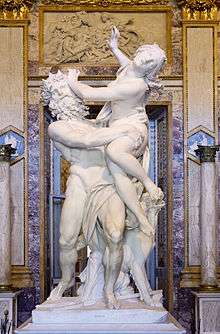 Rape of Proserpina (1621–1622) by Gian Lorenzo Bernini (Borghese Gallery)
Rape of Proserpina (1621–1622) by Gian Lorenzo Bernini (Borghese Gallery)_(cropped).jpg) Apollo and Daphne (1622–1625) by Gian Lorenzo Bernini (Borghese Gallery)
Apollo and Daphne (1622–1625) by Gian Lorenzo Bernini (Borghese Gallery)- David (1623–1624) by Gian Lorenzo Bernini (Borghese Gallery)
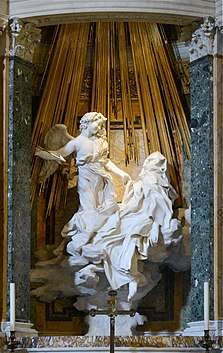 The Ectasy of Saint Teresa (1647-1652), by Gian Lorenzo Bernini (Santa Maria Della Victoria, Rome)
The Ectasy of Saint Teresa (1647-1652), by Gian Lorenzo Bernini (Santa Maria Della Victoria, Rome)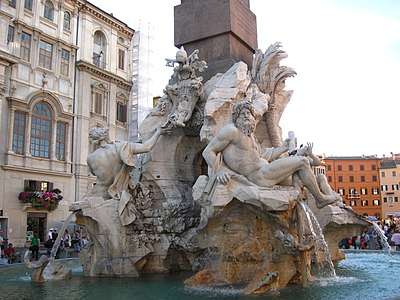 Fountain of the Four Rivers, Rome (1648-1651)
Fountain of the Four Rivers, Rome (1648-1651)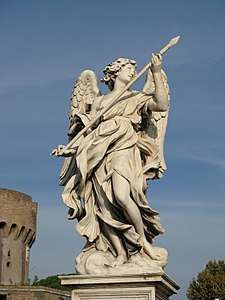 Angel with a Lance (1667-1669) Sant Angelo Bridge, Rome
Angel with a Lance (1667-1669) Sant Angelo Bridge, Rome
Maderno, Mochi, and the other Italian Baroque sculptors
Generous papal commissions made Rome a magnet for sculptors in Italy and across Europe. They decorated churches, squares, and, a Rome specialty, the popular new fountains created around the city by the Popes. Stefano Maderna (1576–1636), originally from Bissone in Lombardy, preceded the work of Bernini. He began his career making reduced-size copies of classical works in bronze. His major large-scale work was a statue of Saint Cecile (1600, for the Church of Saint Cecilia in the Trastevere in Rome. The Saint's body lies stretched out, as if it were in a sarcophagus, evoking a sense of pathos. [8]
Another early important Roman sculptor was Francesco Mochi (1580–1654), born in Montevarchi, near Florence. He made a celebrated bronze equestrian statue of Alexander Farnese for the main square of Piacenza (1620–1625), and a vivid statue of Saint Veronica for Saint Peter's Basilica, so active that she seems to be about to leap from the niche. [8]
Other notable Italian Baroque sculptors included Alessandro Algardi (1598–1654), whose first major commission was the tomb of Pope Leo XI in the Vatican. He was considered a rival of Bernini, though his work was similar in style. His other major works included a large sculpted bas-relief of the legendary meeting between Pope Leo I and Attila the Hun (1646–1653), in which the Pope persuaded Attila not to attack Rome [9]
François Duquesnoy (1597–1643) born in Flanders, was another important figure of the Italian Baroque. He was a friend of the painter Poussin, and was especially known for his statue of Saint Susanna at Santa Maria de Loreto in Rome, and his statue of Saint Andrew (1629–1633) at the Vatican. He was named royal sculptor of Louis XIII of France, but died in 1643 during the journey from Rome to Paris.[10]
Major sculptors in the late period included Niccolo Salvi (1697–1751), whose most famous work was the design of the Trevi Fountain (1732–1751). The fountain also contained allegorical works by other prominent Italian Baroque sculptors, including Filippo della Valle Pietro Bracci, and Giovanni Grossi. The fountain, in all its grandeur and exuberance, represented the final act of the Italian Baroque style.[11]
 St. Cecilia (1599) by Stefano Maderno, Santa Cecelia in Travestere
St. Cecilia (1599) by Stefano Maderno, Santa Cecelia in Travestere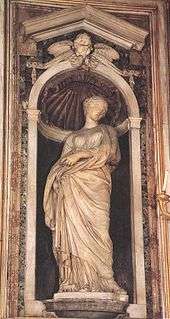 Saint Susana by François Duquesnoy (1629–33), Basilica of Loreto
Saint Susana by François Duquesnoy (1629–33), Basilica of Loreto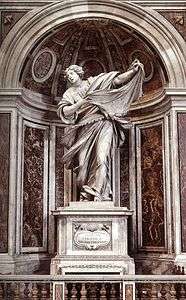 Saint Veronica by Francesco Mochi (1640), the Vatican
Saint Veronica by Francesco Mochi (1640), the Vatican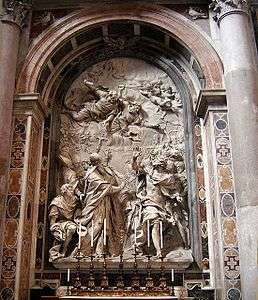 The meeting of Attila the Hun and Pope Leo I (1646–53) by Alessandro Algardi
The meeting of Attila the Hun and Pope Leo I (1646–53) by Alessandro Algardi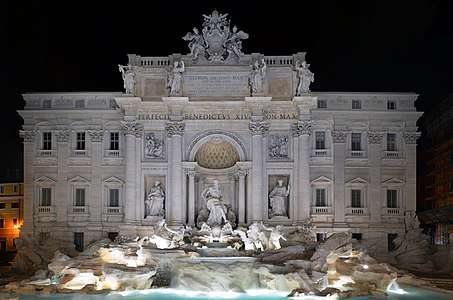 Trevi Fountain, design by Niccolo Salvi (1732–51)
Trevi Fountain, design by Niccolo Salvi (1732–51)
France
The major part of French Baroque sculpture was intended to glorify not the Church, but the French monarch, Louis XIV of France, and his successor, Louis XV. Much of it was produced by the sculptors of the new Royal Academy of Painting and Sculpture, founded in 1648 and later closely supervised by Jean-Baptiste Colbert the King's Minister of Finance. French sculptors worked closely together with painters, architects, and landscape designers such as André Le Notre to create the sculptural effects found in the Palace of Versailles and its gardens, the other royal residences, and the statues for new city squares created in Paris and other French cities. Colbert also established the French Academy in Rome so French sculptors and painters could study classical models.[12]
In the early part of the Baroque period, French sculptors were largely influenced by the painters of Flanders and the Netherlands. particularly the Mannerism of Giambologna, rather than sculpture the Italy. These artists included Germain Pilon (1525–1590);, Jean Varin (1604–1672) and Jacques Sarrazin (1592–1660). Bernini himself, at the peak of his fame, came to Paris in 1665 to present his own plan for the Louvre to Louis XIV. The King did not like Bernini or his work, and the plan was rejected, though Bernini produced a fine bust of Louis XIV now on display at the Palace of Versailles.[13]
The best French sculptors were engaged to make statues for the fountains gardens of the Palace of Versailles and other royal residences. These included Pierre Puget, Jacques Sarazin, François Girardon, Jean-Baptiste Tuby, Antoine Coysevox, and Edme Bouchardon. Guillaume Coustou created a particularly fine group of horses for the gardens of the Château de Marly.[14]
In the later years of the Baroque era, Jean Baptiste Lemoyne (1704–1778), Director of the French Academy in Rome, was considered the finest rococo sculptor, though his fame was eclipsed by his pupil, Jean-Antoine Houdon, who led the transition of French sculpture from the Baroque to classicism.[15]

_-_01.jpg) Basin of Saturn, François Girardon, Palace of Versailles (1672-1677)
Basin of Saturn, François Girardon, Palace of Versailles (1672-1677)- Jean-Baptiste Tuby, Chariot of Apollo, gardens of the Palace of Versailles (1668–70)
 Fame Riding Pegasus by Antoine Coysevox for Marly, now in Louvre (1701-1702)
Fame Riding Pegasus by Antoine Coysevox for Marly, now in Louvre (1701-1702)
The Netherlands and Belgium
After breaking sway from Spain, the predominantly Calvinist United Provinces of the Netherlands produced one sculptor of international repute; Hendrick de Keyser (1565–1621). He also was the chief architect of Amsterdam, and creator of major churches and monuments. His most famous work of sculpture is the tomb of William the Silent (1614–1622) in the Nieuwe Kerk in Delft. The tomb was sculpted of marble, originally black but now white, with bronze statues representing William the Silent, Glory at his feet, and the four Cardinal Virtues at the corners. Since the church was Calvinist, the female figures of the Cardinal Virtues were completely clothed from head to foot.[16]
The southern portions of the Netherlands, which remained largely Catholic, produced a more elaborate Baroque style closer to that of Rome. The most prominent sculptor was Artus Quellinus the Elder, member of a family of famous sculptors and painters, and son of another sculptor, Erasmus Quellinus. He settled in Antwerp in 1639. He became close to Rubens, and his work applied many of the principles of the compositions of Rubens to sculpture.[17]
Another important Belgian Baroque sculptor was Hendrik Frans Verbrugghen (1654–1724), who carved very elaborate sculptures, full of biblical scenes, flora and fauna, allegories and symbols for the ceremonial puppets the cathedrals and churches in Brussels, Louvain, Antwerp, Mechelen, and other cities.[18]
 Tomb of William the Silent by Hendrick de Keyser (1614-1622), painted by Dirk Van Delen, Rijksmuseum (1624)
Tomb of William the Silent by Hendrick de Keyser (1614-1622), painted by Dirk Van Delen, Rijksmuseum (1624)- Anton de Graeff by Artus Quellinus the Elder (1661), Rijksmuseum
- Pulpit of Brussels Cathedral, by Hendrik Frans Verbruggen (1695-1699)
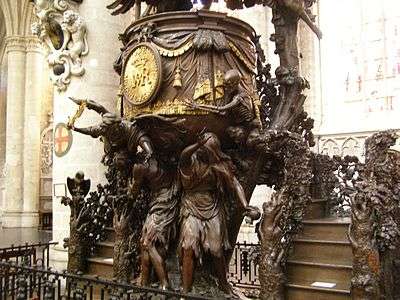 Pulpit of Brussels Cathedral, by Hendrik Frans Verbruggen (1695-1699)
Pulpit of Brussels Cathedral, by Hendrik Frans Verbruggen (1695-1699)- Pulpit in Church of Saint Peter and Paul, Mechelen, by Hendrik Frans Verbruggen
England
Early Baroque sculpture in England was influenced by an influx of refugees from the Wars of Religion on the continent. One of the first English sculptors to adopt the style was Nicholas Stone (Also known as Nicholas Stone the Elder) (1586–1652). He apprenticed with another English sculptor, Isaak James, and then in 1601 with the noted Dutch sculptor Hendrick de Keyser, who had taken sanctuary in England. Stone returned to Holland with de Keyser, married his daughter, and worked in his studio in Holland until he came back to England in 1613. Stone adapted the Baroque style of funeral monuments, for which de Keyser was known, particularly in the tomb of Lady Elizabeth Carey (1617–18) and the tomb of Sir William Curle (1617). Like the Dutch sculptors, he also adapted the use of contrasting black and white marble in the funeral monuments, carefully detailed drapery, and made faces and a hands with a remarkable naturalism and realism. At the same time that he worked as a sculptor, he also collaborated as an architect with Inigo Jones.[19]
Another important figure in English Baroque sculpture was Louis François Roubiliac (1707–1767). Roubiliac was born in France, worked in the studio of Nicolas Coustou in Paris, and in 1730 won the grand prize of the French Academy for a biblical relief sculpture. His traveled to England, married a Protestant, and decided he and his family would be safer in England. In England he discovered by chance a packet of banknotes, which he returned to its owner. The owner was Edward Walpole, natural son of the Prime Minister, who helped introduce Roubilac to aristocratic patrons. His most famous works included a bust of the composer Handel,[20] made during Handel's lifetime for the patron of the Vauxhall Gardens; and the tomb of Joseph and Lady Elizabeth Nightengale (1760). Lady Elizabeth had died tragically of a false childbirth provoked by a stroke of lightning in 1731, and the funeral monument captured with great realism the pathos of her death. His sculptures and busts depicted his subjects as they were; they were dressed in ordinary clothing and given natural postures and expressions, without pretentions of heroism.[21]
- Figure of Temperance by Nicholas Stone, Chilham
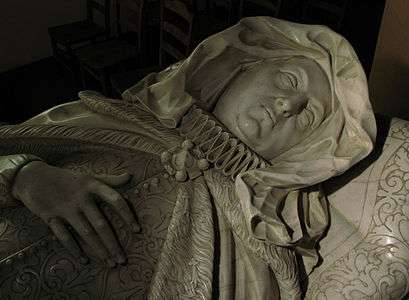 Tomb of Lady Elizabeth Carey by Nicholas Stone (1617-1618), Stowe Nine Churches, Northamptonshire
Tomb of Lady Elizabeth Carey by Nicholas Stone (1617-1618), Stowe Nine Churches, Northamptonshire Monument to John Donne in St. Paul's Cathedral, London, by Nicholas Stone (1631)
Monument to John Donne in St. Paul's Cathedral, London, by Nicholas Stone (1631)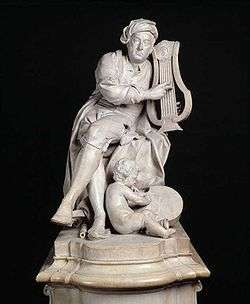 Handel by Louis-François Roubiliac, (1738) Victoria and Albert Museum
Handel by Louis-François Roubiliac, (1738) Victoria and Albert Museum Bust of the physician John Belchier by Louis-François Roubiliac (1749), Royal College of Surgeons, London
Bust of the physician John Belchier by Louis-François Roubiliac (1749), Royal College of Surgeons, London
Germany and the Habsburg Empire
The Baroque movement flourished especially in the end of the 17th century and the beginning of the 18th century in Germany and the states of the Habsburg Empire governed from Vienna. A large number of churches and statues had been destroyed by the Protestant iconoclasts during the Reformation and the Wars of Religion, and large numbers of new works were made to replace them. Many of the new works expressed triumphal themes; Hercules slaying a lion, Saint Michael slaying a dragon, and other subjects which represented the triumph of the Catholic church over th Protestants.[22]
A number of sculptors came from the Netherlands to participate in the reconstruction. They included Hubert Gerhard (1550–1622) from Amsterdam, a student of Giambologna, who was commissioned by the German banker Hans Fugger to make a monumental fountain for his castle at Kirchheim. This was the first Italian Baroque style fountain made north of Alps. Gerhard was soon commissioned to make an Italian-Baroque style fountain for the town square in Augsburg, and a statue of St. Michael slaying a dragon for the prince's residence in Munich. The sculptors Hans Krumper (1570–1634), Hans Reichle (1570–1624) and the Dutch-born Adrien de Vries (1545–1626) made similar monumental bronze fountains and statues, full of action and drama, for church facades and town squares in Bavaria.[23]
One of the most unusual German sculptors in the late Baroque was Franz Xaver Messerschmidt, who was known both for religious sculpture and for a series of sculpted portraits portraying extreme expressions.[24]
Balthasar Permoser (1651–1732) spent fourteen years in Italy, from 1675 to 1689, before becoming court sculptor in Dresden. He worked in Venice, Rome and Florence, and brought the Italian Baroque to Dresden, particularly in the gardens, and the interior decoration of the Zwinger Palace. His most famous work was a sculpture of The Apotheosis of Prince Eugene of Savoy, the general who had defeated the invasion of the Ottoman Turks. The Prince is portrayed with his foot on a defeated Turk, and with the attributes of Hercules. His sculpted pulpit for the Hofkirche in Drsdsen is another masterpiece of Baroque sculpture.[25]
- Hubert Gerhard, Fountain of Augustus in Augsburg, 1589-1594)
 Adriaen de Vries, Hercules slays a dragon (now at Waldstein Palace, Prague)
Adriaen de Vries, Hercules slays a dragon (now at Waldstein Palace, Prague)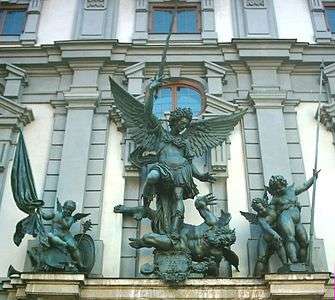 Fountain of the Archangel Michael by Hans Reichle in Augsburg (1603-1606)
Fountain of the Archangel Michael by Hans Reichle in Augsburg (1603-1606)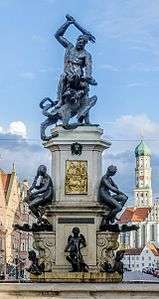 The Hercules Fountain in Augsbourg by Adriaen de Vries (1596-1602)
The Hercules Fountain in Augsbourg by Adriaen de Vries (1596-1602) Yawning by Franz Xaver Messerschmidt (circa 1770)
Yawning by Franz Xaver Messerschmidt (circa 1770)- Pulpit of the Hofkirche in Dresden, by Balthasar Permoser
The most dramatic theater for Baroque sculpture in Germany was church architecture. Particularly complex retables and high altars. crowded with statues and rising almost the ceilings, were created by Hans Riechle, Jorg Zurn, Hans Degler, and other artists. The Michael Zürn family produced several generations of very productive sculptors, making figures of polychrome or gilded wood and stucco. Other artists producing remarkable retables included Thomas Schwanthaler.[26]
In Vienna, the later years of the 18th century produced some extraordinary works, that marked the transition from Baroque into Rococo. These included the Fall of the Angels in Saint Michael's Church in Vienna, by Karl Georg Merville.
 High Altar at Ueberlingen, by Jorg Zurn (about 1613)
High Altar at Ueberlingen, by Jorg Zurn (about 1613) Saint Sebastian, by Michael Zürn
Saint Sebastian, by Michael Zürn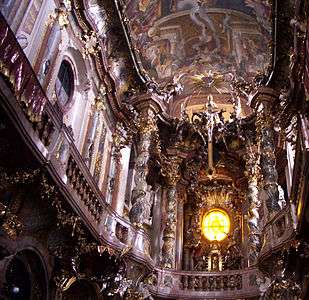 Interior of the Asamkirche in Munich, by Egid Quirin Asam, with sculpture blended into the architecture
Interior of the Asamkirche in Munich, by Egid Quirin Asam, with sculpture blended into the architecture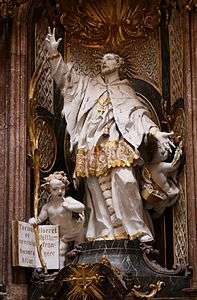 Friesing Chapel by Egid Quirin Asam
Friesing Chapel by Egid Quirin Asam.jpg) The Fall of the Angels, in St. Michaels's Church, Vienna, by Karl Georg Merville (1781)
The Fall of the Angels, in St. Michaels's Church, Vienna, by Karl Georg Merville (1781)
Spain
The emergence of the Baroque style in Spain, as in Italy, was largely driven by the Catholic Church, which used it during the Counter-Reformation as a powerful weapon against the Protestants. The great majority of works were made for tombs, altars and chapels. At the same time, the 17th century was a period of economic decline and political and cultural isolation; few Spanish artists traveled abroad, and only a handful of northern European sculptors, notably the Flemish artist José de Arce, came to Spain. As a result, the Spanish Baroque developed independently of the rest of Europe, and had its own specific characteristics.[27]
The crowning of the French Philip V the grandson of Louis XIV, as King of Spain, and the debut Bourbon Dynasty at the beginning of the 18th century brought a dramatic change in cultural policy, and to the style. Thereafter, commissions for major works of art were controlled by the King, not the church, and the royal Academy of Arts. as in France, determined the subjects, style, and materials. This period continued until about 1770.[28]
Large numbers of sculptures were commissioned for retables, reliquaries and funereal monuments in churches, as well as statuary for religious processions. New themes appeared, particularly works devoted to the cult of the Virgin Mary. The style, designed to popular, inclined toward realism. The materials most commonly used was wood, which was frequently painted in different colors. Beginning in about 1610, one specifically Spanish element of realism appeared; sculptors gave their statues wigs of real hair, used pieces of crystal for teardrops, teeth of real ivory, and skin colors painted with careful realism.[29]
There were two important schools of Spanish sculpture in the early 16th century, that of Castile and that of Andalusia. The emphasis in the Castile school was more on sacrifice and martyrdom, with an abundance vivid suffering. The school of Andalusia generally used greater ornament, and less violence; the infant Christ and the Virgin Mary were more frequent subjects than in Castile.[30] The first center of the Castile style was Valladolid, where King Philip III of Spain resided from 1601–1606. The most important artist of the early Castilian school was Gregorio Fernández (1576–1636). His early work showed extraordinary realism and naturalism, showing all the wounds. His Descent from the Cross in Valladolid, highly detailed and realistic, was made to be carried in processions.[31] His success enabled him to create a large workshop with many assistants, and to make very large-scale works, most notably the retable of the Cathedral of Plasencia made between 1625–32, considered one of the high points of Spanish art in the first half of the 17th century.[32]
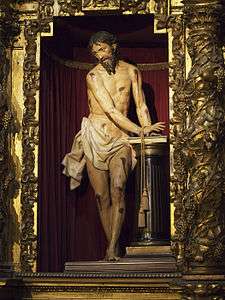 Christ martyred, by Gregorio Fernandez (about 1619), polychrome wood, Valladolid, Vera Cruz
Christ martyred, by Gregorio Fernandez (about 1619), polychrome wood, Valladolid, Vera Cruz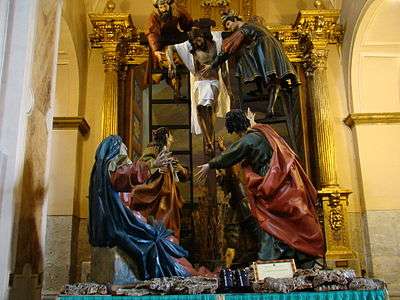 Descent from the Cross by Gregorio Fernandez (1623-1625), polychrome wood, Valladolid
Descent from the Cross by Gregorio Fernandez (1623-1625), polychrome wood, Valladolid- Saint Francis Borgia by Juan Martínez Montañés (1624)
- Retable of Plasencia Cathedral, by Gregorio Fernandez (1625–32)
 Altar of the Hospital de Caidad in Seville (1670–72) of by Pedro Roldán (1624-1699)
Altar of the Hospital de Caidad in Seville (1670–72) of by Pedro Roldán (1624-1699)
The other early center of Spanish baroque sculpture was the city of Seville, which had been greatly enriched by the wealth of the Spanish colonies in the New World. The most important sculptor of the early Seville school was Juan Martínez Montañés (1568–1649), whose works portrayed balance and harmony, with a minimum of violence and blood.[33] Another important Seville sculptor was Pedro Roldán (1624–1699), whose major work was the lavish retable depicting the descent from the Cross of Christ, made for the Hospital de Caidad in Seville (1670–72). The daughter of Roldán, Luisa Roldán (1654–1704), also achieved fame for her work, and became the first woman appointed a royal sculptor in Spain.[34]
Other notable Spanish Baroque sculptors include Alonso Cano of Grenada 1601–1634), who was also active as a painter and sculptor, and whose works featured an idealized naturalism. His pupil, Pedro de Mena (1628–1688), became one of the most important sculptors of the Seville school, with his delicate and realistic life-size statues of Saints.[35]
The early 18th century saw the creation of several lavishly Baroque works, including the altar El Transparente by Narciso Tomé in Toledo, an enormous altar created so that, as light changes, it seems to be moving. It was one of the rare works in Spain to be made of bronze and marble, rather than wood. It was the centerpiece of an enormous complex of art composed of sculpture, painting and architecture which occupies the center of the Cathedral.[36]
With the arrival of the Bourbon Dynasty in power, the center of the art world shifted to Madrid, the source of royal commissions. The isolation of Spanish art from the art of the rest of Europe ended, with the arrival of French and Italian artists, who were invited to decorate the royal palace. It also brought new works of art leaning toward the extreme, including the tortured The Head of Saint Paul by Juan Alonso Villabrille y Ron, along with more delicate works, including a sculpture of Saint Florentine by Francisco Salzillo.
The reign of Charles III of Spain (1760–1788), brought an abrupt end to the Spanish Baroque, and a transition to neoclassicism. The King decreed in 1777 that all altar sculptures and retables had to be approved in advance by the Royal Academy of San Fernando, and that marble and stone, not wood, should be used whenever possible in sculpture.
 The Entombment of Christ, by Luisa Roldán (1654-1704)
The Entombment of Christ, by Luisa Roldán (1654-1704) The Immaculate Conception by Alonso Cano, polychrome wood, Grenada Cathedral (1655)
The Immaculate Conception by Alonso Cano, polychrome wood, Grenada Cathedral (1655)- Mary Magdalene the Penitent by Pedro de Mena (1664)
 The Transparente by Narciso Tomé , marble and bronze, Toledo Cathedral (1704)
The Transparente by Narciso Tomé , marble and bronze, Toledo Cathedral (1704).jpg) Saint Francis Xavier by Luis Salvador Carmona (1750)
Saint Francis Xavier by Luis Salvador Carmona (1750) Saint Florentine by Francisco Salzillo (1755)
Saint Florentine by Francisco Salzillo (1755)
Latin America
The earliest Baroque sculptor and architect to work in Latin America was Pedro de Noguera (1580-) , who was born in Barcelona and apprenticed in Seville. In 1619 he moved to the Viceroyalty of Peru, where, with Martín Alonso de Mesa, he sculpted the Baroque choir stalls of the Cathedral Basilica of Lima (1619-).
The Baroque style of sculpture was transported to other parts of Latin America by Spanish and Portuguese missionaries in the 18th century, who commissioned local artists. It was used primarily in churches. The Quito School in Ecuador was an important group of Baroque sculptors. Prominent artists of the school included Bernardo de Legarda and Caspicara.
Caspicara (1723–1796) was an Ecuadorean artist who made elegant and ornate figures for display in churches. He was a central figure in what is known as the Quito School.
Aleijadinho (1730 or 1738 to 1814), was the son of a Portuguese colonist and an African slave. He is notable for a group of monumental soapstone statues of Saints (1800–1805) for the Santuário de Bom Jesus de Matosinhos in Congonhas, now a UNESCO World Heritage Site. He also made a series of life-sized Passion figures, depicting the events leading to the Crucifixion of Christ (1780–90).
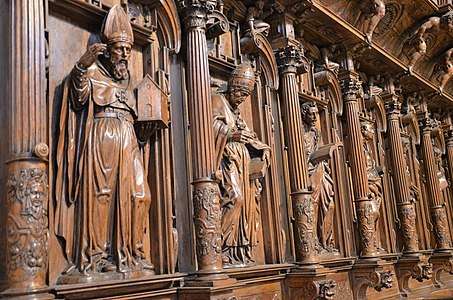 Choir stalls, Cathedral of Lima, Peru, by Pedro de Noguera (1619-)
Choir stalls, Cathedral of Lima, Peru, by Pedro de Noguera (1619-)
_MET_ES2109.jpg) Nativity scene by Caspicara, (Metropolitan Museum of Art) (18th century)
Nativity scene by Caspicara, (Metropolitan Museum of Art) (18th century)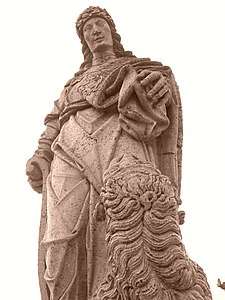 The Prophet Daniel by Aleijadinho in Congonhas (1800-1805)
The Prophet Daniel by Aleijadinho in Congonhas (1800-1805).jpg) Head of Christ, by Aleijadinho, in Congonhas, Brazil
Head of Christ, by Aleijadinho, in Congonhas, Brazil The Road to Golgotha by Aleijadinho in Congonhas (1780-90)
The Road to Golgotha by Aleijadinho in Congonhas (1780-90)
Notes
- Boucher, 134–142 on the Cornaro chapel; see index for Bernini generally
- Boucher, 16–18
- Honour and Fleming, 450
- Honour and Fleming, 460–467
- Geese (2015) pg. 274.
- Geese (2015) pg. 276.
- Geese 2015, pp. 288–289.
- Geese 2015, p. 292.
- Geese 2015, p. 294.
- Geese 2015, p. 295.
- Geese 2015, p. 300-301.
- Article by Uwe Geese in L'Art Baroque – Architecture, Sculpture, Peinture, (2015) H.F. Ullmann, pp. 302–315
- Paul Fréart de Chantelou, Diary of the Cavaliere Bernini’s Visit to France, 1985, ed. Anthony Blunt
- Geese (2015), page 305-309
- Geese (2015), page 314
- Geese, Uwe, Section on Baroque sculpture in L'Art Baroque – Architecture – Sculpture – Peinture pg. 316
- Geese, L'Art Baroque – Architecture – Sculpture – Peinture pg. 316
- Geese, L'Art Baroque – Architecture – Sculpture – Peinture pg. 318
- Geese, L'Art Baroque – Architecture – Sculpture – Peinture pg. 320
- Jackson, Anna (ed.) (2001). V&A: A Hundred Highlights. V&A Publications.CS1 maint: extra text: authors list (link)
- Geese, L'Art Baroque – Architecture – Sculpture – Peinture pg. 321
- Geese, L'Art Baroque – Architecture – Sculpture – Peinture pg. 322
- Geese, pg. 322
- Geese, pg. 346-47
- Geese, pg. 338
- Geese, pg. 346-47
- Redondo, Baroque Sculpture in Spain", pg. 354
- Redondo, pg. 354
- Redondo, pg. 354
- Redondo, pg. 356
- Redondo, pg. 354
- Redondo, pg. 361
- Redondo, pg. 361
- Redondo, pg. 364
- Redondo, pg. 365-68
- Redondo, pg. 368-69
Bibliography
| Wikimedia Commons has media related to Baroque sculptures. |
- Boucher, Bruce, Italian Baroque Sculpture, 1998, Thames & Hudson (World of Art), ISBN 0500203075
- Geese, Uwe, Section on Baroque sculpture in L'Art Baroque – Architecture – Sculpture – Peinture (French translation from German), H.F. Ulmann, Cologne, 2015. (ISBN 978-3-8480-0856-8)
- Jeancolas, Claude (1992). Sculpture Française (in French). Paris: CELIF. ISBN 2-86535-162-9.CS1 maint: ref=harv (link)
- Redondo, José Ignacio Hernánez, Baroque Sculpture in Spain, from Baroque Art - Architecture - Sculpture Painting, H.F. Ullmann, Cologne, 2015. (ISBN 978-3-8480-0856-8)
- Hugh Honour and John Fleming, A World History of Art, 1st edn. 1982 (many later editions), Macmillan, London, page refs to 1984 Macmillan 1st edn. paperback. ISBN 0333371852